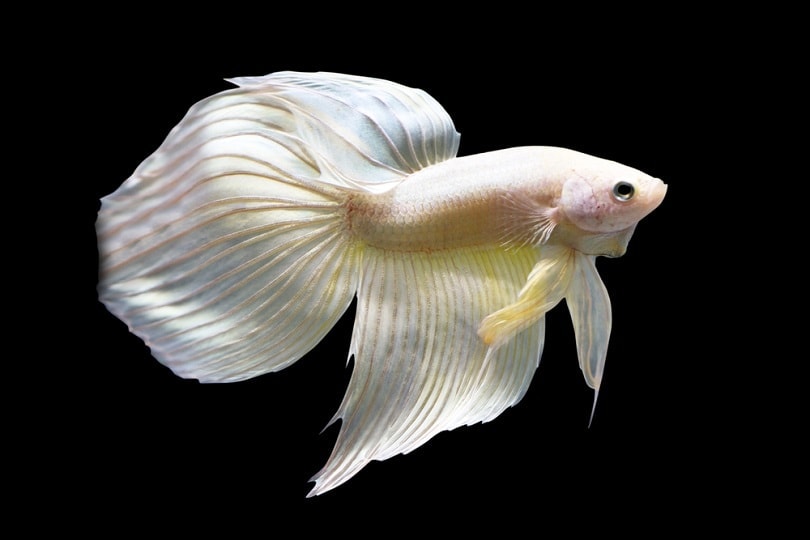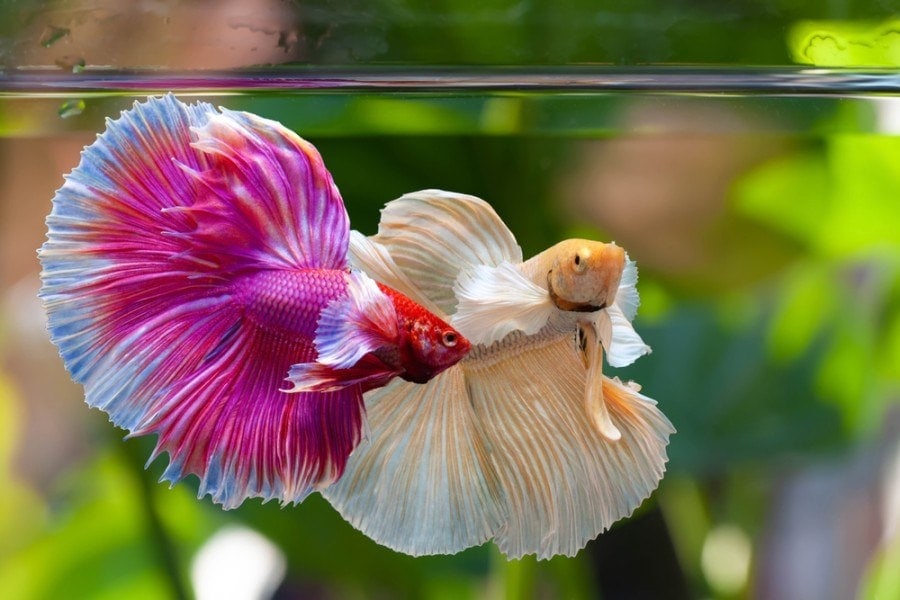Veiltail Betta Fish: Care Guide, Lifespan & More (With Pictures)
Updated on

Click to Skip Ahead
Bettas, or Japanese fighting fish, as they are more commonly known, are renowned for their gorgeous coloring and range of fin and tail varieties. Selective breeding of Bettas has resulted in a massive range of colors and tail types, with the varieties expanding more every year. There is disagreement around exactly how many Bettas varieties there are, although most estimates put the number at 70 or more!
Of these varieties, the Veiltail is one of the most popular and one of the easiest to breed. While this variety may be common and easy to find, they are no less beautiful than other tail types. Read on for more info on the Veiltail Betta.
Quick Facts About Veiltail Betta
| Species Name: | Betta splendens |
| Family: | Osphronemidae |
| Care Level: | Moderate |
| Temperature: | 75–80 degrees Fahrenheit |
| Temperament: | Mostly peaceful, can be territorial at times |
| Color Form: | Yellow, red, blue, orange, black, white, green, pink, purple |
| Lifespan: | 2–4 years |
| Size: | 1.5–2 inches |
| Diet: | Carnivore |
| Minimum Tank Size: | 3 gallons |
| Tank Set-Up: | Filter, lighting, plants |
| Compatibility: | Generally peaceful with other fish species |
Veiltail Betta Overview
The Veiltail Betta is one of the most common Betta varieties and one of the most popular Betta tail types kept in home aquariums. The variety’s popularity has waned somewhat in recent years, though, due to the introduction of more “fancy betta” tail types, such as the Crowntail or Halfmoon, but their ease of breeding still makes them sought after.
The variety has become so common that there are no longer categories for showing Veiltails competitively, although dedicated breeders still see the value in this beautiful variety and are determined to keep it around.

How Much Do Veiltail Bettas Cost?
Since Veiltail Bettas are so widely available and easy to breed, they are also one of the least expensive varieties. Depending on where you purchase them and how old they are, Veiltails typically go for as little as $2 to no more than $6. For comparison, the “fancy” varieties of Bettas can sell for hundreds or even thousands of dollars.
Typical Behavior & Temperament
Veiltail Betta keepers maintain that this variety is more outgoing and friendly than other Betta types, as they will wiggle their tails in the presence of their owners and will even move around the tank to get a better view of their keepers. Despite the Betta’s reputation for fighting and aggression, Veiltails are docile and peaceful fish with calm and pleasant personalities. That said, like all Betta types, male fish will fight in the presence of another male to defend their territory.
Appearance & Varieties
Veiltail Bettas are characterized by a long, swooping and flowing tail that tends to droop from just behind the fin (caudal peduncle). Veiltails come in a wide variety of color combinations, and since this tail type gene is dominant, they are one of the easiest to breed. Males, as with most Bettas, are truly striking and beautiful fish, whereas females tend to have less bright coloration with shorter tails and fins.
How to Take Care of Veiltail Bettas
Veiltails and Betta fish in general are easy to care for, and with the right conditions, they are hardy, healthy fish that can easily live for 5 years and beyond. There is, however, a common misconception that Bettas prefer to live alone and are happy in tiny ornamental fish bowls or vases. This is simply not true. While Bettas do have an aggressive streak, they can peacefully live with other fish and prefer to have a great deal of space in their tank.
Habitat, Tank Conditions & Setup
Tank
The minimum size of tank for your Betta will depend on how many you want to keep and whether you decide to have other fish species with your Bettas. A general rule of thumb is at least 3 gallons for just one Betta, with an extra gallon for each Betta that you add.

Water Parameters
Bettas prefer warmer water conditions of around 75-80 degrees Fahrenheit, with a pH between 6.5 and 7.5. They are hardy fish that can tolerate slightly cooler temperatures but will be far less active and potentially more susceptible to disease.
Plants and Substrate
Gravel is an ideal substrate for Bettas because it doesn’t have sharp edges that can harm them, although they tend to stick to the top of their tank. Plants and floating covers are essential items to add to their tank because they give Bettas cover and make them feel safe and secure.
Lighting and Filtration
Filtration is essential for the cleanliness of your tank and the health of your Bettas, although smaller tanks can get away with having no filter. In this case, you’ll need to change 1/3 of the water every 3–4 days, and a filtered aquarium will need a 25% water change every 2 weeks, with a filter change at least once a month. Never change all of your tank’s water at once.
Bettas need a regular day/night cycle for sleeping, so you should have your aquarium light on a timer that goes off at night.

Are Veiltail Bettas Good Tank Mates?
In general, Bettas make good tank mates despite their fearsome reputation. Male Bettas should never be housed together unless there are plenty of females around, and even then, they may still fight. Females are generally docile with other females and most other fish species.
When housing your Bettas with other fish, it’s important to add them into an established tank — slowly — rather than the other way around. Bettas in their own tank will have established their territory and may see new additions as a threat. Also, do not pair Bettas with other brightly colored fish or fish with long, flowing fins because they will also be seen as a threat by males. Snails, shrimp, and schooling or bottom-feeding fish are the best tank mates for Bettas because they live at a different water level.
What to Feed Your Veiltail Betta
Betta fish are carnivores, and in the wild, they have a fairly varied diet, feeding on small insects and invertebrates from the surface of the water. They need a diet high in protein, so high-protein pellets made especially for Bettas are ideal because they contain all the nutrients that your Betta needs. Avoid other tropical fish food because it is not designed for Betta nutrition. Frozen brine shrimp or bloodworms are great occasional treats for Bettas too.
In general, you’ll want to feed your Betta two to four pellets per day, depending on their age and size. You can substitute frozen or fresh foods 1–2 days per week.
Keeping Your Veiltail Betta Healthy
Despite their ornate appearance, Bettas are hardy, healthy fish overall that suffer from few health issues. With the right water parameters, a healthy diet, and a peaceful, spacious environment, Bettas are healthy, long-lived fish that can live for 5 years and beyond in captivity. If your Betta has strong, vibrant colors and open, relaxed fins and feeds readily, these are all good signs that they are happy and healthy.
Breeding
Bettas breed readily in captivity, leading to their prolific numbers as pets. They’ll need to be bred in a separate aquarium, where they can have their own space. Males can be kept with fry until they begin swimming, at which point males will stop looking after them. Fry can be challenging but rewarding to raise, and with a bit of research and experience, Veiltail Bettas are easy fish to breed, even for beginners.
Are Veiltail Bettas Suitable for Your Aquarium?
Even though the Veiltail is a common and readily available Betta variety, they can still make a beautiful addition to your aquarium. They are known to be more docile, social, and friendly than most other Betta varieties, making them ideal for a community tank of other fish species. Males will be aggressive toward other male Bettas, but with the right conditions and species, they can live peacefully with other fish.
Veiltail Bettas are truly beautiful fish that are relatively easy to care for and make wonderful additions to any aquarium.
Featured Image Credit: Sean McVey, Shutterstock













